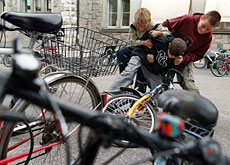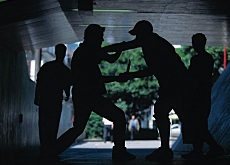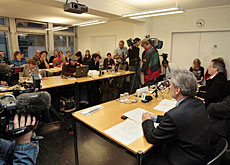Project tackles primary school violence

A Zurich city study of primary school violence has revealed that every second boy and one in five girls in an observation group have been involved in fights.
But the project’s leader played down fears of an increasing trend in playground aggression – despite growing concerns about youth violence in Switzerland, particularly in schools.
The findings come after a series of rape allegations involving schoolchildren. A rogue primary class in Zurich also went through six teachers in a two-and-a-half-year period before being brought to heel.
Manuel Eisner, head of a three-year-long project aimed at curbing violence in youngsters, insists that the latest figures should not be taken out of context. It is common for young children to get involved in pushing and shoving, but this behaviour usually subsides during adolescence, he said.
“There is an extensive debate in Switzerland about whether aggressive child behaviour has increased or not, but ultimately nobody really knows,” Eisner told swissinfo.
“Over the past ten to 15 years there has been a massive increase in violence involving juveniles recorded by the police. There has been a change in the way that teachers, the police and the general public perceive aggressive behaviour in youngsters.
“This has led to an increased likelihood in reporting this behaviour, but I am sceptical of the view that this equates to a rise in aggressive behaviour.”
More worrying for Eisner, a criminologist, is the fact that ten per cent of the 1,300 children studied between their sixth and ninth year of age claimed that they had been subjected to persistent verbal or physical victimisation.
Ethnic minorities
“Children who are victimised on a regular basis tend to develop depression and suffer in their schoolwork so it is not something to be taken lightly,” Eisner pointed out.
Much of the blame for school violence has been laid at the door of children from ethnic backgrounds, an allegation that has been heavily used by some rightwing politicians.
The primary school project found no systematic behavioural differences between this group and Swiss children, but Eisner acknowledged that older youths from ethnic minorities appear more likely to be violent.
“Maybe the cause lies somewhere between primary school and adolescence, possibly because of continued failure at school that causes frustration and resentment,” he said.
The so-called Zurich project on the social development of children has focused on stopping aggressive behaviour during primary school to prevent an escalation during adolescence.
It runs programmes aimed at teaching parents how to deal with problem behaviour and at teaching social responsibility in schools.
Eisner said progress is being made but urged more to be done to reach out to immigrant families and to help teachers balance behaviour control with academic teaching.
swissinfo, Matthew Allen in Zurich
The Zurich project on the social development of children was commissioned by the city authorities in December 2003.
Professor Eisner led the study of more than 1,300 primary school children between 2004 and 2007.
Teachers, parents and the children themselves were asked about their behaviour and how likely they were to become involved in fights.
Eisner, a criminologist at Zurich and Cambridge universities, also published a 1999 report on youth crime in Switzerland.
14,106 youths (11,189 boys and 2,917 girls) were convicted of crimes in 2005, according to the Federal Statistics Office. The figure is up about 2,000 on 1999.
The overall level of recorded youth crime in canton Zurich dropped 9.6% in 2006 from the previous year. But police warned that instances of serious violent crime are on the increase.
Canton Zurich police chief Bernhard Herren earlier this year called for the expulsion of immigrant youths convicted of crimes along with their families in serious cases.
A study by Bern university hospital, released in February, revealed that twice as many people were admitted with injuries from violence in 2006 than in 1999.

In compliance with the JTI standards
More: SWI swissinfo.ch certified by the Journalism Trust Initiative



You can find an overview of ongoing debates with our journalists here . Please join us!
If you want to start a conversation about a topic raised in this article or want to report factual errors, email us at english@swissinfo.ch.